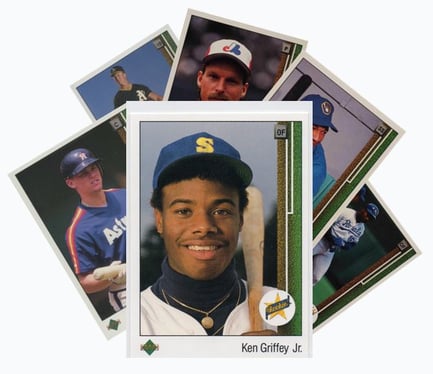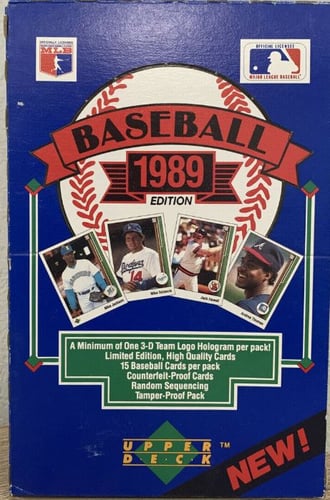The Changes Sparked by the 1989 Upper Deck Set
In 1989 Upper Deck helped change the way baseball cards were viewed. It took the first step in revolutionizing what was perceived as a child’s hobby and transformed it into the big money, high-spending business that we know today.

And then by incorporating certified autographs as inserts into its products a year later, the company was able to revolutionize something basic into something more, something many collectors hold sacred.
The Cards
During the late winter of 1989, Upper Deck gave collectors a breath of fresh air with an initial set of 700 cards delivering sharp, full color photos on the fronts – and backs – tamper proof foil packaging and hologram technology that would help deter counterfeit versions of not just the popular cards but any card in the set.
Included in this debut release were rookies of Roberto Alomar Jr., Gary Sheffield, Craig Biggio, John Smoltz, Randy Johnson, and of course, the famous Ken Griffey Jr. rookie card as the very first card of the set.
Despite its immense importance in the hobby’s history, the set is still somewhat affordable today. Most of these future Hall of Famers can be found for reasonable prices (in ungraded condition), and thus, can easily be added to any collector's collection ranging from the novice to the expert.

Graded cards do demand a premium price. For instance, a PSA 10 graded Ken Griffey Jr. rookie card currently has a tangible market value in the mid $4,000’s range but that's been increasing. In fact, the most expensive PSA 10 Ken Griffey Jr. rookie card sold for $7,000 in February 2021.
The Security
As noted above, Upper Deck revealed several new techniques in the fields of card security. Cards featured holograms on their card-backs to deter counterfeiters. Packs were also now made of foil, instead of the more traditional wax wrapping. This meant that the days of dealers and collectors opening wax packs, replacing the best cards, and re-sealing them were long gone.
Having said that, it is worth noting that 1989 Upper Deck boxes did not feature any type of shrink wrapping, so it's quite possible that the packing sequence of the cards can be deciphered. This can lead more meticulous collectors to pull the exact packs with Ken Griffey Jr. rookies in them and leave the rest.
If you are looking to buy a 1989 Upper Deck box today, you should do so from a trusted source, to avoid any previous potential tampering with the product.
The Boxes
1989 Upper Deck baseball was released in two series, a low and a high. The low series (1-700) sells at a premium to the high as it has a greater potential for a Ken Griffey Jr rookie. The high series (1-800) tend to sell at about 75-85% of the value of the low series boxes. Currently low series foil boxes that are authenticated sell in the $500+ range. Each box contains 36 packs with 15 cards and a hologram disc.
In addition, the company made "factory sets." Sealed sets currently sell in the $300+ range.

An interesting note here is that Factory Set boxes were factory sealed, while wax boxes were not.
Error Cards
One of the trends from the sets in the late 1980’s and early 90’s were error cards. The fact of the matter was that there was only a couple of months from the time Upper Deck received a license to create baseball cards until they were initially released in February. Thus errors abounded. In the 1989 Upper Deck set, some copies of card number 357 featured a reverse negative of Dale Murphy, which was later corrected making it "a variation card." The error card is actually quite a bit tougher to find, so ironically it is actually more valuable than the corrected item.
Other notable errors and variations in this set were the upside-down SS box on Gary Sheffield’s card, and the missing position on Pat Sheridan’s card. Other cards with variations include Gary Varsho, Brian Holton, Bill Schroeder, Herm Winningham, and Fred Manrique.
Late that season, Upper Deck also released a 100-card high series set, capping the inaugural release at 800 cards. That final series included a few memorable cards , such as a triple exposure photograph card of Jim Abbot, a card of Nolan Ran throwing a football while training, and rookie cards of Omar Vizquel.
The Impact
Quite simply, Upper Deck revolutionized baseball cards in 1989! From that point forward, there were different brands using new technology to make their cards stand out from the rest. In 1990, it was 1990 Leaf, which was the premiere card of that year. In 1991, it was Topps Stadium that used Kodak technology for their cards. In 1992, it was Ultra. In 1993, the super-premium cards were born with Topps Finest and SP (also an Upper Deck brand). ...and that'll be another story for another day.
Want to continue reading? Here are a few posts you might find interesting:
- A Look Back At The 1986-87 Fleer Basketball Set
- 1989 Ken Griffey Jr. Rookie: The Improbable Foresight of Upper Deck
- Ichiro Suzuki Rookie: What is the value of "Once in a Lifetime Cards?"
- Investing In Fleer Michael Jordan Cards? Here Is What You Need To Know

